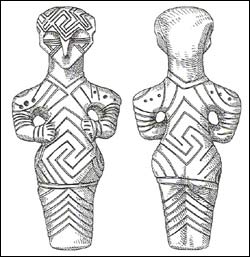Signs of Civilization: International Symposium on the Symbol System of Southeast Europe
Novi Sad, Serbia and Montenegro
May 25-29, 2004
 This interdisciplinary symposium was organized in collaboration with the Novi Sad Branch of the Serbian Academy of Sciences and Arts and was held at its formal facility in Novi Sad. We would like to thank President Zoran Kovačević, Professor Dr. Bogdan Brukner, and the entire staff of the Novi Sad Branch of SASA for generously hosting this international symposium.
This interdisciplinary symposium was organized in collaboration with the Novi Sad Branch of the Serbian Academy of Sciences and Arts and was held at its formal facility in Novi Sad. We would like to thank President Zoran Kovačević, Professor Dr. Bogdan Brukner, and the entire staff of the Novi Sad Branch of SASA for generously hosting this international symposium.
Archaeologists, linguists and other specialists from Eastern and Western Europe and the United States came together to investigate the corpus of linear inscriptions that developed in the Danube basin during the sixth millennium BC. An extensive repertoire of signs and symbols became a universal feature of the Neolithic cultures of Southeastern Europe through the fifth millennium BC and continued in some regions into later periods. The use of graphic communication at such an early date is significant for an understanding of the roots of literacy within the context of European civilization.
Dr. Andrej Starović, expertly curated a special exhibition of engraved Vinča artifacts displayed in the SASA gallery during the symposium.
To see the exhibition catalogue, as well as the published volume of symposium papers – SIGNS OF CIVILIZATION – click on Current Publications.
Presentations:
Dusko Aleksovski ~ Republic of Macedonia
“The origin of the Vinča script in rock art symbolism”
Bogdan Brukner ~ Serbia and Montenegro
“Non-verbal messages on the clay figurines of the Vinča culture”
Stefan Chohadziev ~ Bulgaria
“One Chalcolithic game”
Tanya Dzhanfezova ~ Bulgaria
“Towards the meaning of the pintaderas’ ornamentation”
Harald Haarmann ~ Finland
“The Danube script and other ancient writing systems: A typology of distinctive features”
Borislav Jovanović ~ Serbia and Montenegro
“The symbolic signs on the stone sacrificial altar from Vlasac: The transition from the Late Mesolithic to the Early Neolithic (the beginning of the Lepenski Vir culture)”
Ioannis Liritzis (in absentia) ~ Rhodes, Greece
(collaborative paper with K.T. Frantzi, and A. Sampson)
“A preliminary comparative study of early letters using an objective matching algorithm”
Cornelia-Magda Lazarovici ~ Romania
“Signs and symbols in the Cucuteni culture”
Gheorge Lazarovici ~ Romania
“Databases for spiritual life: signs and symbols ”
Marco Merlini ~ Italy
“A preliminary anthropometric analysis of the ‘Tartaria Project’ ”
Gareth Owens ~ Greece
“Was there a ‘script’ in the Final Neolithic of Greece?”
Iuliu Paul (in absentia) ~ Romania
“About the origin and evolution of Neo-Eneolithic signs and symbols, seen in the light of some discoveries from the Carpatho-Danubian area”
Adrian Poruciuc ~ Romania
“The old fairy of the netherworld with pen in hand”
Adamantios Sampson ~ Rhodes, Greece
“Neolithic and Bronze Age incised symbols in the Greek area”
Andrej Starovic ~ Serbia and Montenegro
“Contextual Analysis of the Vinča signs in Serbia: Symbols of Neolithic spoken language”
Taras Tkachuk ~ Ukraine
“The ornamentation of the Trypillya -Cucutenian painted pottery as symbol systems”
Vytautas Tumenas ~ Lithuania
“The connections between Old European signs and Lithuanian sash ornamentation”
Shan Winn ~ USA
“The Danube (Old European) script: The ritual use of signs in the Balkan-Danube region c. 5200-3500 BC”
Mikhail Videiko ~ Ukraine
“Signs and sign systems of the Trypillya culture, c. 5400-2750 BC”
Lydia Ruyle ~ USA
Lydia’s banners of inscribed figurines accompanied the symposium exhibition.